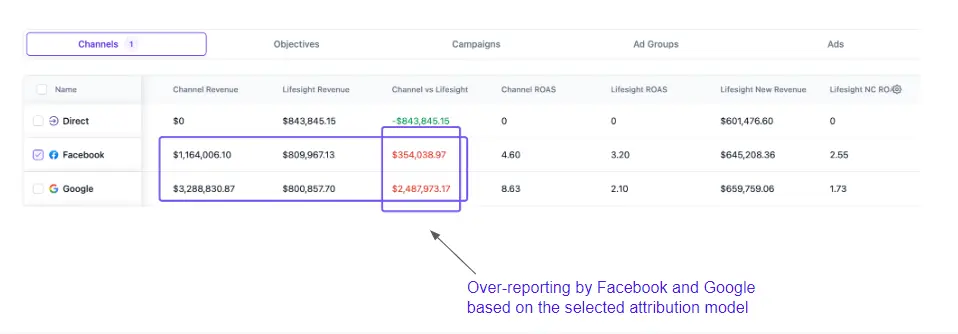The marketing industry is undergoing significant changes, and traditional attribution models struggle to keep up. Today’s marketers face many challenges that were not present even a few years ago. Consumer-focused privacy technology and constantly changing regulations make it harder to track user behavior accurately. Also, the disjointed approach to measuring marketing efforts across online and offline channels exacerbates these challenges, making it difficult to get a holistic view of marketing performance.
In this blog, we’ll uncover why the existing marketing attribution systems are faltering and explore the need for a more adaptive, holistic approach that aligns more closely with long-term marketing effectiveness rather than just short-term efficiencies.
The loss of signal in attribution models
The loss of signal in attribution models has become a significant issue in marketing, primarily due to sweeping privacy changes and increased consumer sensitivity towards data usage. Traditional attribution models, which once thrived on rich, user-level data, face major obstacles undermining their accuracy and reliability.
As privacy regulations such as GDPR in Europe and CCPA in California tighten, the amount of user-specific data that can be legally and ethically collected is dwindling. These laws mandate that user consent be obtained before tracking their activities, significantly reducing the data pool available for analysis. As a result, marketers are often left with incomplete data sets that no longer provide a full picture of user behaviors and campaign touchpoints.
This loss of detailed data leads directly to a breakdown in traditional attribution models, designed under the assumption of nearly unrestricted data access. These models depend on tracking an individual’s interactions with a brand across different channels to determine the most influential interactions in the purchasing decision. Without access to comprehensive user-level data, these models struggle to accurately attribute sales or conversions to specific marketing efforts, potentially misallocating marketing budgets and resources.
The ROAS deception
ROAS is a commonly used metric that measures the revenue generated for every dollar spent on advertising. While it seems straightforward and valuable, it often provides an incomplete and misleading view of a campaign’s true effectiveness.
One of the main issues with platform-reported ROAS figures is that they can be inflated. Advertising platforms like Google and Facebook are vested in demonstrating their effectiveness, so their reported ROAS might not account for the nuances of multi-touch attribution. Although many advanced attribution tools now incorporate multi-touch attribution to provide a more comprehensive view, platform-reported metrics can still overestimate the impact of specific ads by ignoring other critical touchpoints in the customer journey. This can result in overestimating the impact of specific ads and underestimating the role of other channels and interactions contributing to the sale.
over-reporting-by-facebook-&-google-based-on-selected-attributions
Another deceptive aspect of ROAS is that it doesn’t account for the costs of acquiring and retaining customers beyond the initial purchase. High ROAS might look impressive, but if the cost to serve these customers or the rate of returns and churn is high, the actual profitability can be much lower than it appears. This can lead to strategic decisions prioritizing high-ROAS campaigns that are not necessarily the most profitable or sustainable in the long run.
The fraud and transparency issue
Digital marketing fraud can take many forms, from click fraud in pay-per-click campaigns to fake traffic generated by bots, which artificially inflate engagement statistics and skew attribution results. These deceptive practices lead to significant financial losses and make it difficult for marketers to determine the true effectiveness of their campaigns. When decisions are based on corrupted data, the result is not just wasted spend but also strategic missteps that can derail marketing efforts.
Many attribution technologies operate as “black boxes,” providing little insight into how data is processed or how decisions are derived. This lack of clarity makes it difficult for marketers to trust the results and to justify marketing spend to stakeholders. Without a clear understanding of the attribution model’s inner workings, marketers are left questioning the validity of the data points and the recommendations based on those points.
Moreover, the industry is rife with vendors that promise unparalleled insights and results, often using opaque methodologies that cannot be easily verified or replicated. This environment creates a breeding ground for mistrust, as marketers cannot fully audit or understand the basis of the attribution claims made.
Correlation v/s causation
Many attribution models rely heavily on correlation-based analysis, which can result in an incomplete and often misleading understanding of what truly drives marketing success.
Correlation measures the relationship between two variables, indicating how they move together. For instance, an increase in ad spend might correlate with an increase in sales. However, correlation does not imply that one variable causes the other to change. This is where the distinction between correlation and causation becomes crucial. Just because two variables move together does not mean that one is directly causing the other to occur.
Traditional attribution models often assume that correlated events are causally linked. For example, if a spike in sales follows a social media campaign, the attribution model might attribute the sales increase directly to the campaign without considering other potential factors. These could include seasonal trends, concurrent marketing efforts, or broader economic conditions influencing sales.
This reliance on correlation can lead to overestimating the impact of certain marketing activities while underestimating others. It can create a false sense of security around the effectiveness of specific campaigns and result in continuing to invest in strategies that may not be as effective as they appear. Conversely, activities that genuinely drive sales but do not show a strong correlation due to other influencing factors might be undervalued or ignored.
Also, not all traditional models make this mistake; some sophisticated models already incorporate causal inference techniques.
Marketers need to incorporate causation-based approaches in their attribution models to overcome this limitation. This method involves more sophisticated statistical analyses and often requires controlled experiments like randomized testing to validate the causal relationships.
The inadequacy of attribution across channels
The inadequacy of attribution across channels is a significant flaw in traditional marketing measurement. Many attribution models fail to capture the full scope of how different channels contribute to a customer’s journey, leading to an incomplete and often misleading picture of marketing effectiveness.
Firstly, consider how consumers interact with brands today. They move seamlessly across multiple channels, from social media to email, from search engines to direct website visits. Traditional attribution models, which often focus on the last click or a single interaction, do not account for this multi-channel behavior. This results in an oversimplified view that misses the synergistic effects of different marketing efforts working together.
Moreover, using a one-size-fits-all attribution model across all channels can lead to significant inaccuracies. Each marketing channel has its unique characteristics and plays a different role in the customer journey. For example, social media might be more effective for raising awareness and engagement, while email marketing might be better at driving conversions. A model that treats all channels the same cannot accurately reflect their individual contributions and interactions.
Additionally, the lack of integration between online and offline channels further compounds this inadequacy. Many traditional attribution models do not consider offline interactions, such as in-store visits or phone calls, which are crucial parts of the customer journey. This siloed approach results in an incomplete understanding of how marketing efforts drive overall business outcomes. While some traditional and advanced models account for multi-channel interactions, they might not be the majority.
Manson Chen, founder of Sovran suggests using surveys, incrementality tests, and MMM to draw a better picture for your marketing efforts.
manson-chen-post-about-attribution-is-broken
The future: Unified marketing measurement
Unified Marketing Measurement represents a holistic approach to measuring marketing effectiveness. It utilizes a blend of deterministic and probabilistic methodologies to navigate the complexities of consumer behavior and channel efficacy.
As no single measurement method can claim to be the absolute truth, UMM employs triangulation, leveraging three robust techniques: marketing mix modeling, multi-touch attribution, and incrementality testing. This triad works in concert to peel back the layers of marketing influence, providing a richer, more nuanced view of what truly drives performance and engagement. The industry is shifting towards more sophisticated attribution models and the increasing availability of tools that address the highlighted issues.
With the marketing measurement solution by Lifesight, you can understand the true impact of your marketing efforts while maintaining consumer privacy. Book a demo today!
You may also like
Essential resources for your success
























































